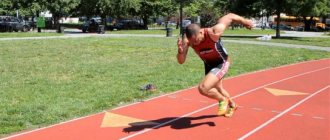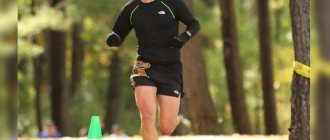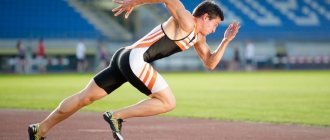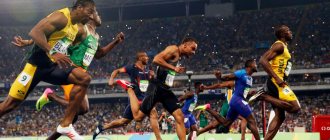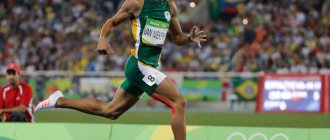Running 200 meters standards for men and women
Since the physiological characteristics of men and women differ, the standards for running the 200 meters are different for different genders.
Important! In women, the endurance factor is 15% lower than in representatives of the stronger half of humanity. In addition, men and women have different heart and lung volumes.
Thus, the standards for the 200-meter run are as follows.
| Rank, rank | Men | Women |
| MSMK | — | — |
| MS | 21,1 | 24,0 |
| KMS | 21,8 | 25,2 |
| 1 adult category | 22,8 | 26,6 |
| 2nd adult category | 24,0 | 28,5 |
| 3 adult category | 25,7 | 31,0 |
| 1 youth category | 26,7 | 32,4 |
| 2nd youth category | 28,0 | 34,0 |
| 3rd youth category | 29,4 | 36,0 |
Methods of training to run 200 meters
Running is a natural human activity, so the ability to do it is genetic. However, running technique without training cannot be ideal , and inconsistent and incorrect training will not only negatively affect running technique, but can also deprive the athlete of the advantages that nature has endowed him with.
Therefore, the following training method for 200-meter running is recommended:
- acquaintance with the history of sprint running - the concept of standards, techniques, and so on;
- demonstration of running technique in a straight line for 40-60 meters;
- exercises in place with practicing hand movements - jumping in place, running with a high hip lift, mincing running;
- learning to run on turns - running in a circle at different speeds, running in a straight line entering a turn, running from the middle of a turn;
- start and acceleration technique - running from a high and low start;
- Low start technique when turning – running at different speeds when turning;
- as well as finishing techniques - “chest throw”, “shoulder finish”, “running”.
Features of preparation
A good 200m sprinter can be competitive in both the 100m and 400m. This is because 200m sprinters need to apply the training principles of both the 100m and 400m. It's about explosiveness and speed endurance.
To achieve success at this distance, your training requires a much greater focus on speed endurance. But in addition to working on developing neuromuscular patterns and honing sprint form, the athlete will need a tactical plan.
The plan may differ from race to race depending on what track the athlete is on, how many races he has to run, and what weather conditions will be at the time of the start.
The training of such sprinters is similar to the training of 100-meter sprinters, but with the difference that the former perform longer intervals, do more work series and have less recovery time between sets. So, for endurance you need to run segments of 400-800 m, and to create a sprinting base - short accelerations of 60-100 m.
However, you can still find one strong difference from the preparation for the 100 m.
The 100-meter runner runs the race in a straight line, while the 200-meter runners have to start on a bend, and this changes the way the body works: the feet are placed on the surface with a turn to the left, the right hand moves slightly inward, and the left in the opposite direction, almost half the distance the body struggles with centrifugal force.
Arc running is a separate important component that athletes practice in training.
Like other sprinters, 200m runners finish with their torsos thrown forward. There are such methods: “chest throw”, “running”, “shoulder finish”. These technical aspects are also honed during preparation.
Requirements for an athlete for a distance of 200 meters
The 200m sprint places high demands on the athlete. In order to reach maximum speed as soon as possible from the start, and then maintain it for at least most of the distance, the runner must be well prepared physically, have strength and good coordination .
To perform successfully, the athlete must have a height of 165-195 cm, the optimal height is 175 cm.
The ideal weight for a sprinter is considered to be height minus 102 kg. If an athlete’s height is 180 cm, then his weight should be 78 kg. In this case, there should be no fat pad, only dry muscles. In addition, the athlete must have a good metabolism. It must be able to spend and save glycogen.
The stronger the athlete, the higher his running speed . A sprinter must perform a chest press of 130 kg, a squat of 230 kg, and a leg press of 460 kg. The sprinter must deadlift with a load of 210 kg. These are ideal indicators.
Finishing
The length of the finishing throw is 150-200 m (half a circle) and depends on the physiological capabilities of the athlete. The runner’s torso leans forward, the frequency of arm swings and steps increases, but just before the finish line the technique breaks down due to muscle fatigue.
The tactic for middle distance running is to maintain a constant speed throughout the race. To do this, you need to choose the most suitable running pace and stick to it. Pacemakers are often involved in competitive races - runners who set the rhythm. Their task is to lead a certain segment of the distance at a speed that suits the leading runners.
Power Training Program
The training program for sprinters includes:
- running at close range with the maximum frequency of steps (in place);
- running without support with a maximum frequency of steps (in place);
- hand movements are fast, like running;
- jumping on one leg;
- running in short steps with maximum frequency;
- shuttle run;
- running through medicine balls as fast as possible;
- running up the stairs with maximum frequency;
- running up the stairs every 2-3 steps;
- high hip lift;
- variable running;
- jumping in place;
- jumping forward;
- as well as jumping over medicine balls;
- strength exercises.
Training involves cycles of 2 weeks, during which the athlete trains 5 times a week. As your fitness improves, the load increases. It is recommended to conduct classes at the same time so that the body gets used to the increasing loads. Warm-up is carried out especially carefully, since sprinters perform work that dramatically increases the load on muscles and joints.
Important! During training, you need to monitor your heart rate - it should not exceed 190 beats per minute.
At first, the athlete’s pulse during training should not exceed 140 beats; the next series and approaches can be performed after the heart rate drops to 110 beats per minute.
Every two weeks, the volume of training should be increased by 50% of the original. If an athlete trains without equipment, the volume of training increases by 4. For example, if an athlete with a barbell squats 7 times, then without a barbell he must squat 28 times.
Plyometric training is resistance exercise . These are jumps that require the athlete to remain on the floor as little as possible, squats with weight, jumping for a distance with two legs together, jumping up with a push-off with one leg, jumping from a height (in depth).
Weightlifting exercises - sharp and smooth cleans, as well as intense presses, power presses with weights, push presses, power cleans.
As for intensity, plyometric exercises are performed for 5 sets of 3 repetitions, and weightlifting exercises are performed for 5 repetitions for 2 sets, while the athlete is given 2-3 minutes of rest between sets.
Distance running
The length of the steps gradually lengthens (190-240 cm), and the speed increases.
By 30 m distance the speed reaches 90-95% of the maximum.
Running along the distance (Fig. 6.6, a - c) should be smooth and without jerking.
Usually one of the athlete’s legs is stronger, so the length of the steps is uneven.
In order to avoid this, you should develop a weaker leg.
The foot is placed exclusively on the toe and on the toe, without resting on the heel (Fig. 6.7). The push-off is sharp and powerful due to the strength of the foot.
The work of the arms must be coordinated with the work of the legs.
The hand is semi-compressed or freely extended (Fig. 6.8, a). If you clench your hand into a fist or turn your straight fingers outward, this will change the trajectory of the hand movement (Fig. 6.8, b). The arms are bent at the elbow joint at an angle of 90°, the hands are raised forward to the level of the chin.
What are the subtleties in nutrition?
The ratio of proteins, fats and carbohydrates in a sprinter’s diet is as follows:
- in the off-season – 20-20-60;
- at the preparation stage – 25-20-55;
- in season – 30-15-55.
During exercise that lasts more than 10 minutes, the aerobic mechanism becomes the main source of energy, so athletes are recommended to drink sports cocktails during training. You need to select something that will help the athlete explode at the start and maintain the desired pace subsequently.
For sprinters, it is important to provide maximum power for a short period of time, therefore, adequate protein intake is necessary.
With prolonged exercise, the body becomes dehydrated, which means mineral salts are washed out of it. Mineral reserves must be constantly replenished. It is also important to take vitamin C, which removes free radicals formed during significant aerobic exercise. Thus, it is necessary to select the optimal multivitamin-mineral complex for continuous use.
Creatine is a product that increases endurance; carbohydrate drinks and other products that have increased biological value are also useful.
Important! It is recommended to use sports nutrition on the advice of a trainer; it should be taken regularly along with the main diet.
Starting, running and finishing technique
There are two types of start – low and high. Most often, a low start is used, as it has a comfortable position and makes it possible to make a more powerful push. At the start, the athlete takes the following position - the pushing leg is in front, the swing leg is behind. You need to bend your arms at the elbows and relax your shoulder girdle. At the “start” command, the body weight is transferred to the pushing legs, the pelvis is located at the level of the shoulder girdle. On the command “march” you need to push off from the blocks with maximum force.
Next comes the starting acceleration - 3 powerful steps. In this case, the head is lowered down and the torso is tilted forward. After 30-40 meters, the athlete’s body gradually levels out - the runner raises his head, looks forward, the body is tilted forward only 5-7 degrees.
Finishing can be done using one of the following options:
- Chest throw - a meter before the finish line, the body sharply bends forward, arms are pulled back.
- Finish sideways - turn your body sideways towards the finish line.
Basic competition rules
In the qualifying rounds, runners who have managed to achieve a certain temporary result as part of their athletics federation are allowed to participate in international tournaments. Selection for the Olympics is carried out in 4 rounds: preliminary heat, quarterfinals, semifinals and finals.
The start in all sprint disciplines is taken from a low position (in some cases from the blocks). While running, athletes are prohibited from crossing the boundary line of someone else's track. The only exceptions are the 4 x 400 meter relay races. At competitions under the auspices of the IAAF, stadiums are always equipped with an automatic timekeeping system, as well as a photo finish.
In open sports arenas, in the event of a strong tailwind, the so-called wind component is subtracted from the runners' performance. If his speed is more than 2 m/s, then the athlete’s final result cannot be considered a personal or official record.
Preparations for the race begin with the command “To the start”. At this time, the sprinters take the starting position in the blocks. The “Attention” command serves as a signal to end preparations for the race. The sprint begins after the referee fires. If the athlete runs out before the shot is fired, then a false start is recorded. For such a violation, the athlete is removed from the race.
The final place taken by the runner is recorded by a photo finish. It is determined by the surface of the athlete’s torso. Limbs, neck and head are not taken into account by the system. The photo finish image automatically sets the electronic timing time.
Recommendations from professionals
Professionals emphasize that the sprinter experiences enormous loads, so safety precautions must be observed:
- Before the start, you should definitely warm up - it’s best to jog for 10 minutes, do squats and bends so that your body and muscles warm up and get ready for running.
- Do a cool-down - immediately after completing the distance, you need to start jogging, and then walk, and move until your pulse and breathing return to normal.
- Choose the right shoes and clothes - clothes should not restrict the athlete’s movement, and shoes should have shock-absorbing soles, good heel support and comfortable lacing.
Not every athlete can do sprinting; some use it only as training. But in any case, this running discipline allows you to overcome yourself and discover new capabilities of your body.

